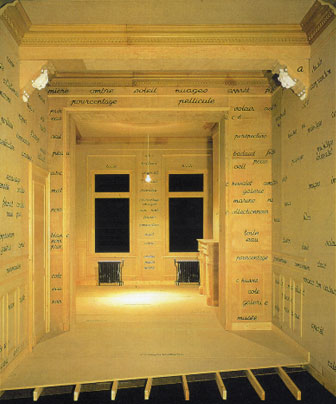Décor
Marcel
Broodthaers focuses on the sphere of the museum in his study of the definitions
of art and its distribution systems, starting from a rejection of the
traditional framework of the institution. In his work he plays with the
stability of artistic categories, subverts the traditional relations between
the art object and the presentation and reception systems. He questions
the museum from the relations between the work and the social environment,
in other words, he questions the very function of the work and the public.
He uses decontextualisation and accumulation techniques which allow him
to tackle different levels of fiction of the work and the exhibition:
the decorated décor is an illusion, the artificiality of
the art event taken to the extreme, in contrast with the idea of truth
of the traditional art object.
In Broodthaers’ work there is an interest in giving the same status
to the word as to the image. Language is understood as a system of representation
and reality in itself. It was no accident that in 1969 he put on a literary
exhibition about Mallarmé at the Wide White Space in Antwerp, and
in the same year, by replacing the text with black stripes, he reinterpreted
the publication of the poet’s Un coup de dés jamais n’abolira
le hasard. Those works investigated new ways of arranging words in
space and their use as a work of art, according to a poetic procedure.
In 1975 he presented the exhibition L’Angelus de Daumier at
the Centre National d’Art Contemporain in Paris, at which each room
had the name of a colour. La Salle blanche was a reconstruction,
as faithful as possible (?), —the question mark he added himself—
of a work done in 1968 in Brussels, the result of a protest movement which
marked the Belgium art world at the time and culminated in the occupation
of the Palais des Beaux Arts. In the first version, he installed a kind
of museum open to the public in his studio so that, on the one hand, he
subverted the notion of the official institution, and on the other, questioned
the relation of the museum and the work, since the works were reduced
to mere reproductions and the condition of merchandise. In the second
version of La Salle blanche, which we are presenting at MACBA,
a space reconstructs a pre-existing place. In this case, art and language
are literally united and the artist’s discourse is transferred to
the walls of the room reconstructed on the same scale, covered with words
referring to the world of art.

Marcel Broodthaers,
La Salle blanche, 1975
